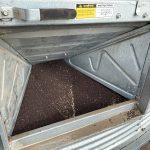GSI’s GrainVue bin monitoring system allows producers to monitor grain conditions inside the bin and automate any drying, cooling or aerating that is needed to keep grain in peak condition.
Tag Archives grain storage

GSI’s GrainVue allows for remote grain bin monitoring
Customizable system can automatically control aeration, drying and cooling

Wireless grain monitoring is a grain spoilage saviour
GrainX offers producers the ability to focus on harvest while they manage grain quality
GrainX is a wireless grain storage monitoring service and technology company whose data is sent to the cloud for producers to access via computer and smartphone.

Wavcor introduces Manhole Aeration System
Many farms have older hopper-bottom bins without aeration systems, which limits their usefulness. A new system from Saskatoon-based Wavcor provides a low-cost way to do that.

Canola storage requires continued vigilance
Using fans and taking care during canola harvest can help prevent hot canola and spoilage issues
Successful canola storage for Prairie farmers starts with proper management at harvest time, and then continues through the winter months.

Speedy U.S. harvest strains producers, storage
A massive influx of corn, soybean crops pressures tired workers and stretches the storage system to the breaking point
CHICAGO, Ill. (Reuters) — U.S. farmers are harvesting two of the largest corn and soybean crops in history at the fastest pace in years, straining their physical capabilities and grain storage capacity. The massive influx of crops is testing growers who are already grappling with grain prices near four-year lows, stiff competition for global export […] Read more
Ag productivity hampered by policy: speakers
Panelists warn that if Canada doesn’t find ways to make itself attractive to agri-food businesses, other countries will
Glacier FarmMedia – Agriculture and the agri-food sector can be a powerful tool for Canada both economically and geopolitcally. That’s according to Jack Mintz, economist and president’s fellow at the University of Calgary’s Public Policy Institute. Agriculture is a high-productivity sector with great strategic opportunities on the world stage, he told attendees of the Protein […] Read more
Speed vs. quality at harvest time
Harvest time always brings the urgency of getting the crop off the fields as fast as possible, but that need for speed must be balanced with the need to avoid damage. Research at North Dakota State University looked at the issue, beginning with dry beans because their value is particularly vulnerable to issues such as […] Read more

How to reduce grain handling and storage hazards
Handling and storing grain are dangerous tasks that expose farmers to numerous hazards. Power take-off (PTO) entanglements and suffocation from grain engulfment or entrapment are two of the most common incidents involving grain. To reduce safety risks, farmers should prepare grain bins ahead of harvest. The Canadian Agricultural Safety Association (CASA) recommends removing garbage and […] Read more

Producers encouraged to invest in on-farm storage at Canada’s Outdoor Farm Show 2024
Glacier FarmMedia – Farmers shouldn’t let lower grain prices dissuade them from building bins — if anything they could pay higher dividends in a tough market say sales representatives from bin-maker AGI. “If there’s a $1 a bushel move in the price of corn between harvest and February, when you’re selling some grain, that can […] Read more

Farm consolidation drives big bin trend
Take a drive in the country in many parts of Western Canada and you’re likely to see some truly immense grain storage facilities, some with stairs spiraling around to the top of corrugated steel giants many metres tall. Paul Brisebois, senior vice-president for Canada with grain storage and handling company AGI, says the trend to […] Read more



